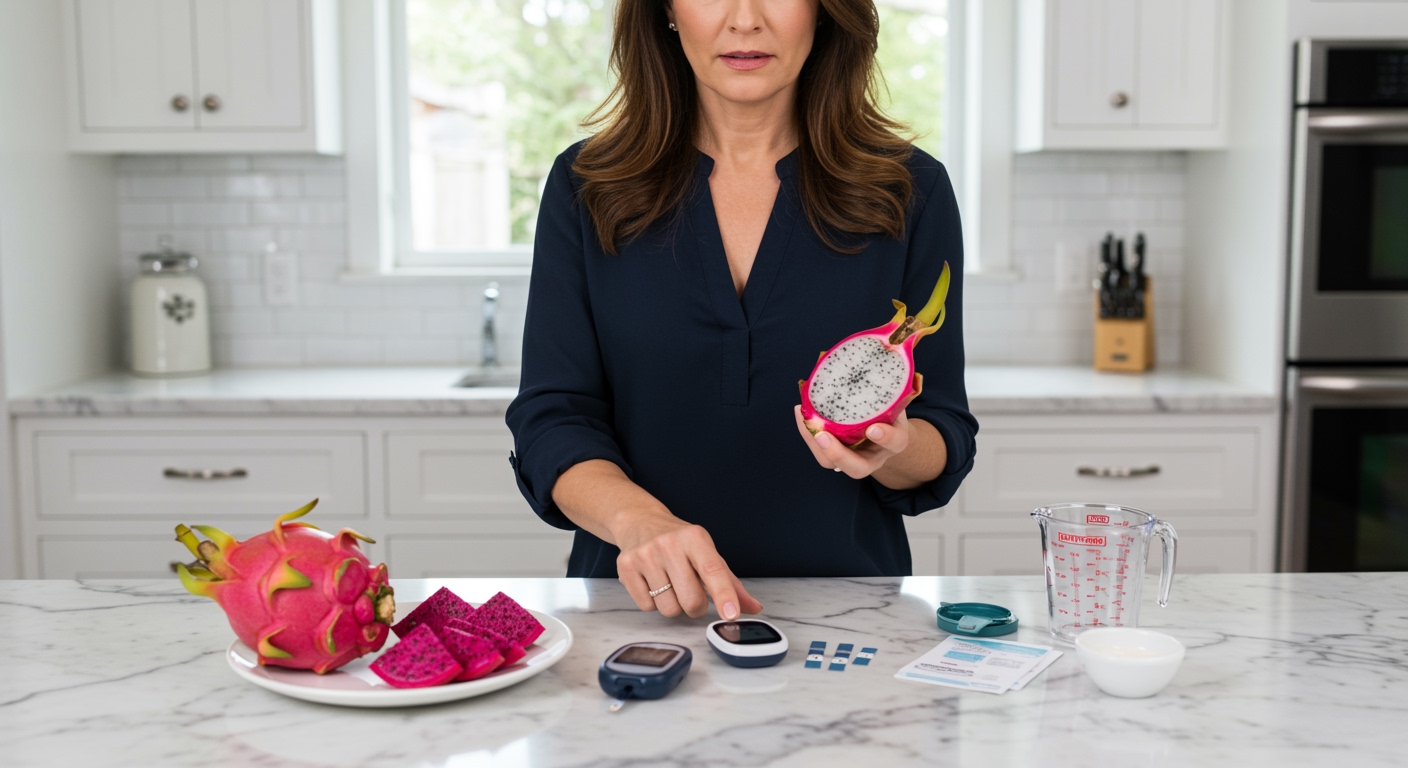✪ Key Takeaway: Dragon fruit is safe for diabetes with a low glycemic index of 25-35, but portion control remains essential.
Introduction
Dragon fruit sits in the produce section looking like something from another planet.
You might wonder if this exotic fruit will spike your blood sugar like other sweet fruits do.
Hi, I’m Abdur, your nutrition coach and today I’m going to explain exactly how dragon fruit affects your blood sugar and whether it belongs in your diabetes management plan.
What Makes Dragon Fruit Different From Other Fruits?
Dragon fruit contains significantly less sugar than most tropical fruits you know.
A 100-gram serving provides only 7-9 grams of natural sugars compared to 16 grams in bananas or 13 grams in mangoes.
The fruit’s high water content makes up about 90% of its weight, which dilutes the sugar concentration naturally.
This unique composition means your digestive system processes dragon fruit sugars more slowly than concentrated sweet fruits.
The fiber content in dragon fruit creates a protective barrier in your intestines that slows sugar absorption into your bloodstream.
Your pancreas responds with a gentler insulin release because the glucose enters your system gradually rather than flooding it all at once.
✪ Fact: Dragon fruit has 60% less sugar than grapes and 40% less than apples per serving.
How Does Dragon Fruit Affect Your Blood Sugar?
Dragon fruit has a glycemic index between 25-35, placing it firmly in the low category.
Foods with glycemic index values below 55 cause minimal blood sugar spikes, making them safer choices for diabetics.
The fruit’s natural antioxidants including betalains and vitamin C may actually improve your insulin sensitivity over time.
When you eat dragon fruit, the sugars enter your bloodstream slowly because the fiber forms a gel-like substance in your stomach.
This gel slows gastric emptying, which means food moves from your stomach to your small intestine at a controlled pace.
Your blood glucose levels rise gradually rather than spiking dramatically, giving your body time to produce adequate insulin.
Research shows that people with diabetes who eat low glycemic fruits like dragon fruit experience better long-term blood sugar control.
✪ Pro Tip: Eat dragon fruit with a small amount of protein or healthy fat to slow sugar absorption even more.
What About Portion Size and Timing?
One cup of cubed dragon fruit contains about 8 grams of sugar, which fits comfortably into most diabetic meal plans.
The American Diabetes Association recommends limiting fruit servings to 15 grams of carbohydrates per portion.
Dragon fruit provides approximately 13 grams of total carbohydrates per cup, staying within these guidelines.
Eating dragon fruit earlier in the day gives your body more time to process the natural sugars through physical activity.
Your insulin sensitivity is naturally higher in the morning, making breakfast or lunch the optimal times for fruit consumption.
Combining dragon fruit with protein sources like Greek yogurt or nuts creates a balanced snack that prevents blood sugar spikes.
The protein triggers the release of incretin hormones that slow digestion and improve insulin response.
✪ Note: Monitor your blood sugar 2 hours after eating dragon fruit to understand your personal response.
Are There Any Hidden Risks?
Dragon fruit is generally safe for diabetics, but individual responses can vary significantly.
Some people experience digestive upset when eating large amounts due to the fruit’s high fiber content.
The seeds contain small amounts of healthy fats but can cause stomach discomfort if you eat too many at once.
Dragon fruit’s natural diuretic properties may affect people taking certain diabetes medications that impact kidney function.
If you take blood-thinning medications, the vitamin C in dragon fruit could potentially enhance their effects.
Always test your blood sugar response to new foods, even those considered diabetes-friendly.
Your body’s reaction depends on factors like stress levels, sleep quality, medication timing, and overall health status.
✪ Pro Tip: Start with half a cup of dragon fruit and monitor your blood sugar response before increasing portions.
The Bottom Line
Dragon fruit is one of the safest fruit choices for people managing diabetes due to its low glycemic index and minimal sugar content.
Smart food choices are not about restriction but about making informed decisions that support your health goals.
What questions do you have about incorporating dragon fruit into your diabetes management plan, and have you noticed any specific blood sugar responses when trying new fruits?
References
At NutritionCrown, we use quality and credible sources to ensure our content is accurate and trustworthy. Below are the sources referenced in creating this article:
- PMC: Dragon Fruit Nutritional Analysis
- January AI: Dragon Fruit Glycemic Index
- Apollo247: Dragon Fruit for Diabetes Management
- Signos: Dragon Fruit Glycemic Index Guide





